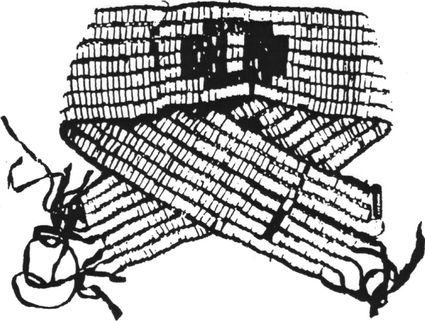The Dish with One Spoon
In the Great Law of Peace, it is stated that:
It will turn out well for us to do this: we will say, ‘We promise to have only one dish among us; in it will be beaver tail and no knife will be there’... We will have one dish, which means that we will all have equal shares of the game roaming about in the hunting grounds and fields, and then everything will become peaceful among all of the people; and there will be no knife near our dish; which means that if there is a knife were there, someone might presently get cut, causing bloodshed, and this is troublesome, should it happen thus, and for this reason there should be no knife near our dish.
[Concerning the League, p. 458]
The Lords of the Confederacy shall eat together from one bowl the feast of cooked beaver’s tail. While they are eating they are to use no sharp utensils for if they should they might accidentally cut one another and bloodshed would follow. All measures must be taken to prevent the spilling of blood in any way.
[Parker, p. 45]
At first glance, this does not look like a land use law at all. To understand its impact, one must first understand the Haudenosaunee views of land and ownership. To the people, the first kind of land was “my people’s village”. This included not only the palisaded, protected area around the longhouses, but also the cleared fields around it.
Within the cleared lands, each clan would have its own fields, which the men would clear and the women would cultivate. At the edge of the clearing was a real boundary…the woods’ edge.
At the woods’ edge, visitors would wait to be greeted, condoled, taken by the hand and brought into the village. Beyond the woods’ edge were the hunting grounds.
Each nation had its own hunting grounds. There are references in early European records of dealings with the Haudenosaunee that the boundaries of the hunting grounds were sometimes marked with trees. Beyond each nation’s hunting grounds were the hunting grounds and lands of other nations.
The Dish with One Spoon wampum belt, with the round purple area in the centre symbolizing the dish. It was kept at the Six Nations Grand River Territory by Skanawati (John Buck) until his death. In 1927, Evelyn H.C. Johnson delivered it to the Royal Ontario Museum, though she claimed no ownership in it. Photograph courtesy of Dept. of Ethnology, Royal Ontario Museum, Toronto.
Ownership of land, in the European sense, and “title”, would have been alien to this traditional view of the world. Underlying the alienness would have been the different senses of time between indigenous and settler peoples. Indigenous peoples were taught that their presence on the land was transitory, part of a continuum from their ancestors to “the coming faces”, the unborn generations. European land ownership involved placing the name of the present owner in a registry book, so that he could then do with the land as he wished. Where the indigenous peoples held the land communally, the Europeans held it individually. In the relative freedom of the Americas, that individuality was being expressed even more strongly than it had ever been in Europe.
The “shared dish of beaver tail stew” meant that the hunting grounds---as distinct from the cultivated lands and clearings---were like one dish or bowl, intended to feed everyone equally. If you were hunting for food in the territory of another nation of the Confederacy, you were within your rights under the Great Law.
The Chiefs, as symbols of their people, were to share in the stew, using only one wooden spoon. This reinforced the sharing, but it also meant that there were to be no knives---”sharp edges”---used, so that there would be no conflict or bloodshed over hunting for food.
Much of the Great Law brought ways to prevent or avoid bloodshed and conflict for the future. The sharing of the hunting grounds was an important way.
This part of the Great Law of Peace was preserved on a wampum belt, as were many other crucial elements of the law. The belt is short, narrow, plain and very old. It bears a round purple area---the dish with one spoon---on a field of white.
This agreement, originating in the laws of the Haudenosaunee, was then extrapolated to other levels and nations as the Confederacy was expanded in its influence and scope. From the point of view of the Haudenosaunee, the power of the Great Law of Peace, and the rationality of its structures and laws, made its acceptance by other peoples a natural and expected occurrence.
The first European record of the Dish with One Spoon is recorded in the Jesuit Relation of 1644-45, at a council between the Haudenosaunee and the French:
“Things are going well” said all the guests; “We eat all together, and we have but one dish”.
[Jesuit Relations, Goldthwaite, Ed. 1644-45, p. 303]
On April 7, 1757, Thomas Butler wrote to Sir William Johnson about a meeting between the Haudenosaunee and the French at Montreal. According to his report, the Haudenosaunee told the French:
...we can’t write but know all that has past between us having good memories.
after the Warrs & troubles we together met you at this place where every trouble was buried & a fire kindled here. Where was to meet and Treat peaceably; you are daily now working disturbances and Seem to forget the old agreement &c. The Tree Seems to be falling, let it be now put up the Roots spread and the leaves flourish as before. You formerly said take this bowl and this meat with this Spoon let us Eat always friendly together out the one Dish but you now forget and have separated the Indians very much So as they can’t well come together To Eat out this Dish which is very hard as we have children here & there Scatred through ye Country by your Means.
The English your Brothers & you are the common disturbers of this Country. I say you white people together. We term the English your Brothers as you must have some. We Indians you call Children you both want to put us Indians a quarreling but we the Six Nations know better if we begin We see nothing but an Intire Ruin of us as we would leve of till all was Gone. So we are Resolved to keep Friends on both sides as long at possible & not meddle with the Hatchet but endeavor always To pacify the white people Our arms shall be between you endeavoring to keep you a Sunder.
[Sir William Johnson Papers, II, 705]
After the defeat of the French in 1760, the British soon found themselves looked upon as possible arbitrators in hunting territory disputes between the nations who had been allies of France. The Algonquins and Nipissings complained that the Mohawks were trespassing on their Ottawa Valley hunting grounds, which they (the Algonquins and Nipissings) had been harvesting in a gradual and deliberate manner. The British Indian Department officials at first replied that the Royal Proclamation of 1763 had reserved the territories west of the Quebec boundary to all the Indian nations together, so that there were no more hunting grounds that could be claimed by individual nations exclusively. The same kinds of conflicts arose when the Haudenosaunee in general began to hunt northward into territory claimed by Kahnawake. The principles of the Dish with One Spoon began to be mingled with the terms of later treaties—between aboriginal nations and communities, with the French, and with the British. In these disputes, though, the issues were generally those which involved commercial trapping or hunting. The fundamental principle of the land being a source of food for all was never in issue.
On August 30, 1765, Daniel Claus, the Deputy Superintendent General of Indian affairs, wrote to Sir William Johnson about the hunting rights of the people of Kanawake and potential conflicts with the Mohawks, Oneidas and Onondagas. Claus and the Kahnawake people linked the Dish with One Spoon to the general Treaty with the French in 1701: he asked Johnson to “interfere”
and remind those Nations of the old Agreement made before the French Governor many Years ago, in the presence of Five Confederate, and all the other Nations in Canada, ---that when a general Peace was made, and concluded between these Nations, the Governor told them, that as they were become one body, and of one mind, the Woods, and Hunting Grounds could be no otherwise than in common, and free to one Nation as to another, in the same manner as a large Dish of Meat would be to a Company of People who were invited to eat it, when every Guest has liberty to cut as they pleased, wherefore they hoped you wou’d make these three Nations abide by that Agreement.
[Sir William Johnson Papers, XI:917]
Continued next week












Reader Comments(0)